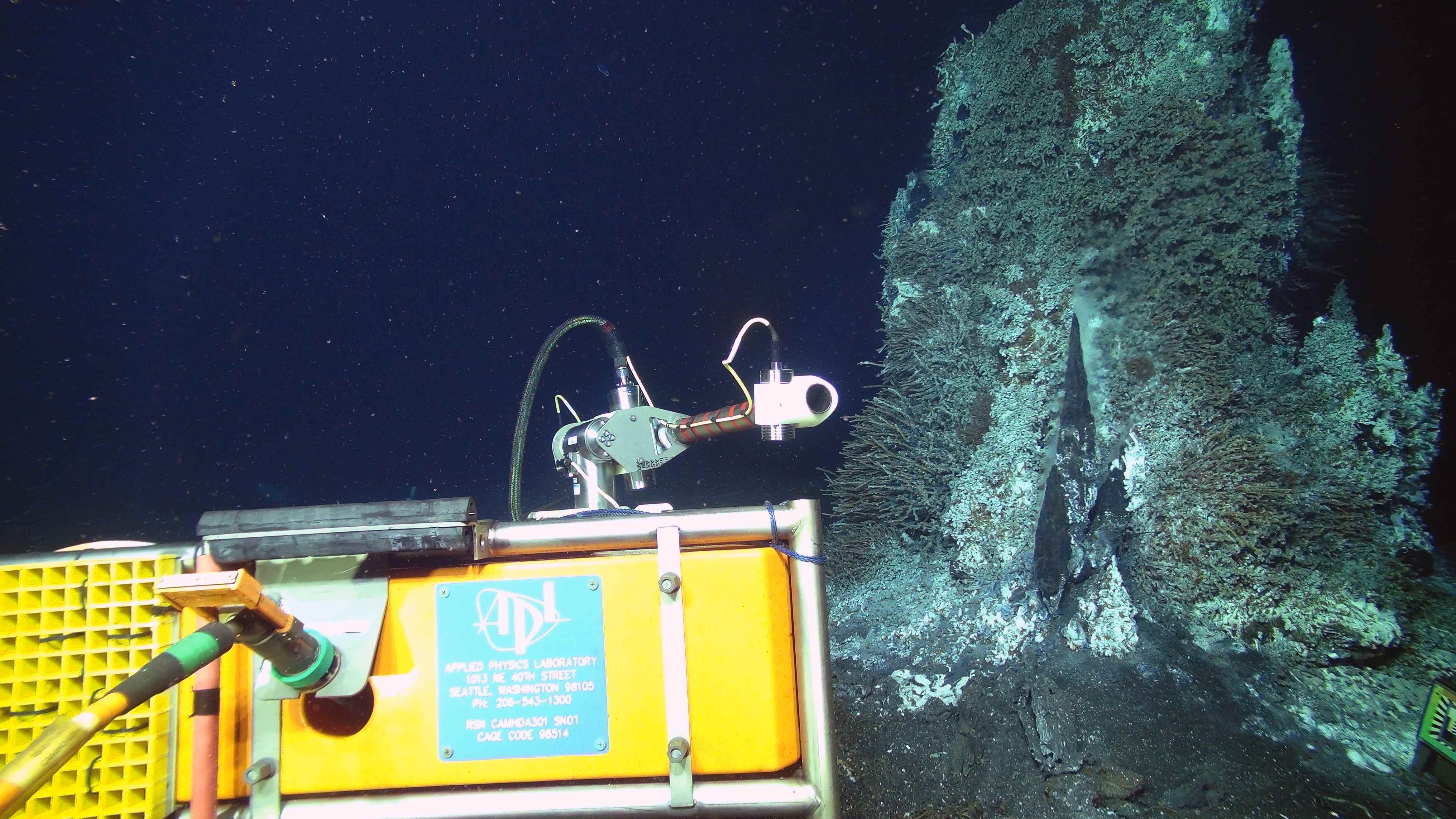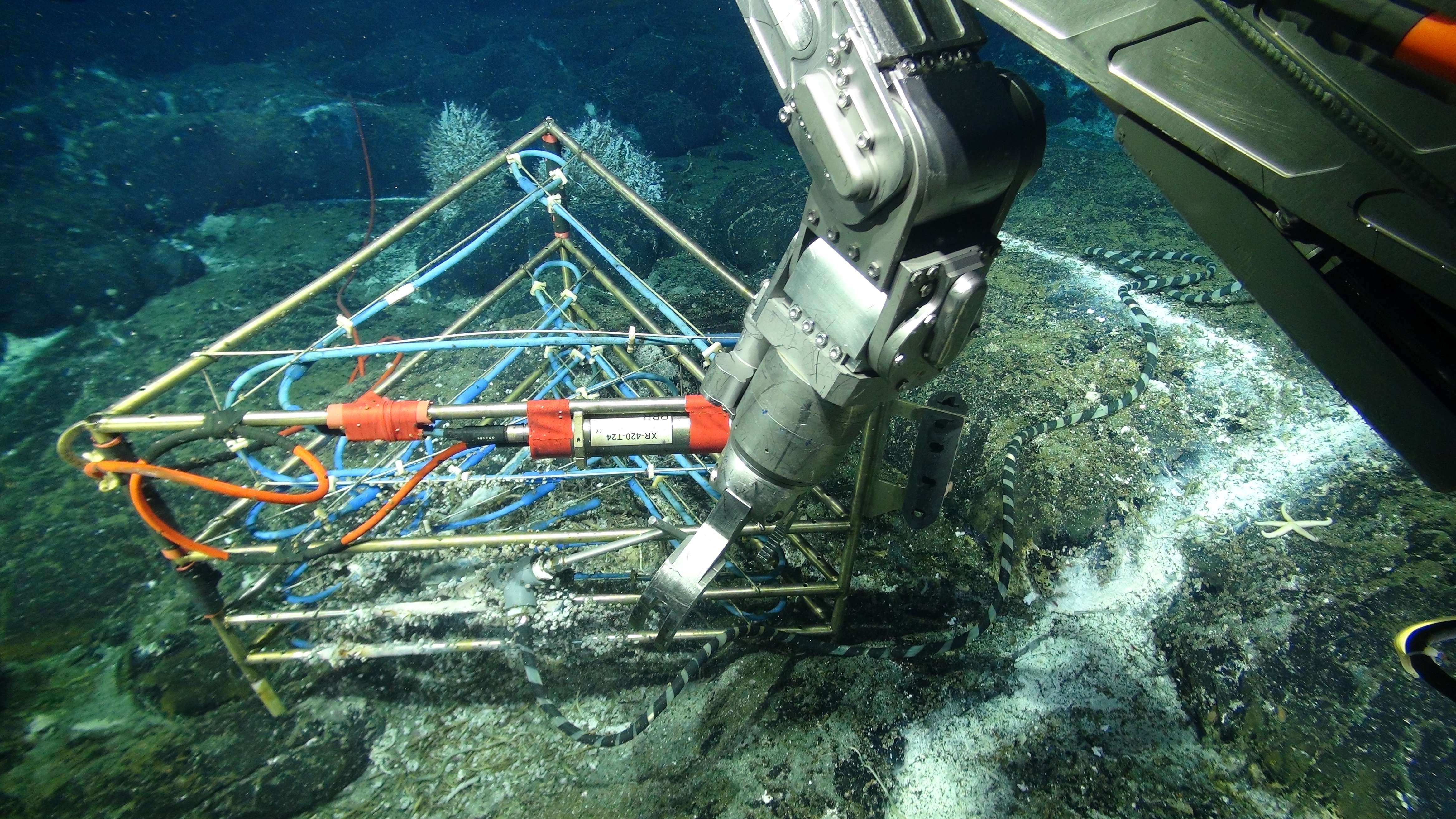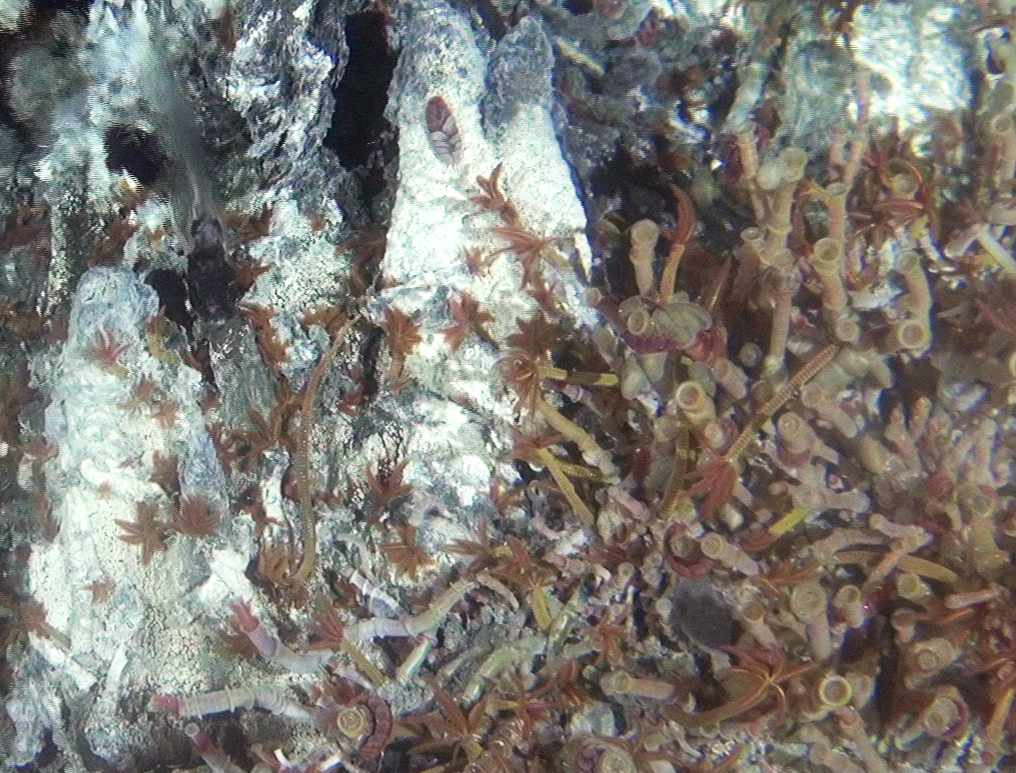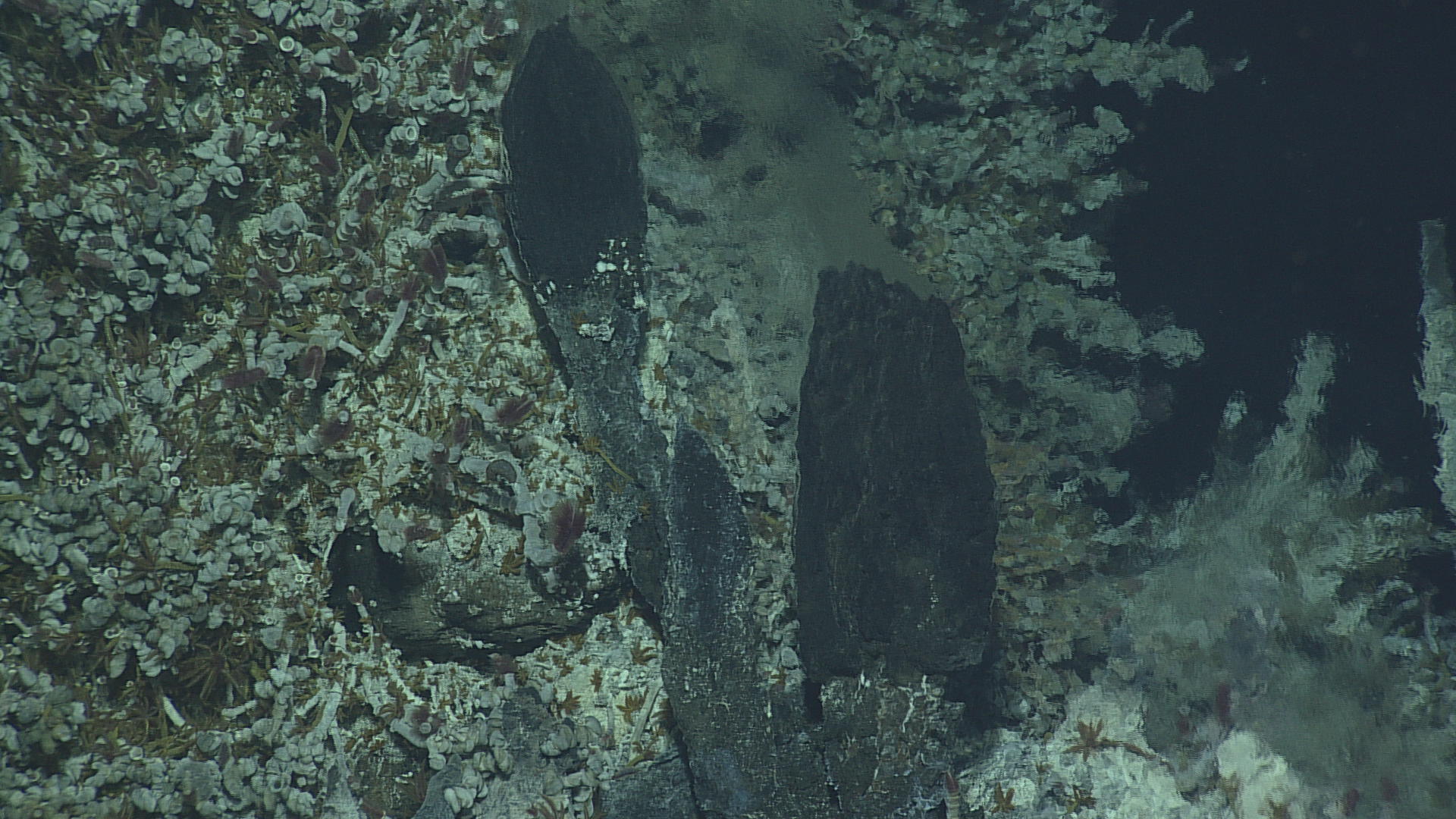Image Archive


















The high definition camera once again lights up the Mushroom hydrothermal edifice. Credit: UW/NSF-OOI/WHOI. V20.

The high definition camera is redeployed on the west side of the ~ 3.5 m tall actively venting chimney Mushroom in the ASHES vent field. Credit: UW/NSF-OOI/WHOI V20.

Beautiful purple-blue ciliates, white filamentous bacteria and tube worms with red hemoglobin-filled plumes, and limpets colonize the outside of the Mushroom edifice at ASHES. Credit: UW/NSF-OOI/WHOI V20.

During testing of the cabled high definition camera, which streams live imagery to shore every three hours, the camera lights up Jason at working at nearly a mile beneath the oceans surface on this active volcano. Credit: UW/OOI-NSF. V20.

The orifice at the base of the hydrothermal chimney called Mushroom is marked by a strong jet of high temperature hydrothermal fluid. Sulfide worms, scale worms and limpets are bathed in a mixture of the high temperature fluid and seawater. Credit: UW/NSF-OOI/WHOI, V18.

The UW-APL-built high definition camera lights up the 12-13 ft tall hot spring deposit called Mushroom, nearly 5000 ft beneath the oceans surface at the summit of Axial Seamount. Credit: UW/NSF-OOI/WHOI,V18.

LED lights on the high definition camera, built by the Applied Physics Laboratory at the University of Washington, light up a ~1 m tall, young black smoker chimney at the base of the actively venting Mushroom edifice on Axial Seamount (water depth ~1500 m). The image, taken with the ROV Jason, shows the camera being tested by UW engineers during VISIONS16. They were in the Operations Center, located 300 miles to the east at the School of Oceanography. Here, they were commanding/controlling the camera live through the terrestrial and submarine Internet as part of the NSF Cabled Array infrastructure. Credit: UW/NSF-OOI/WHOI; V16.

A new osmotic fluid sampler is about to be installed in a diffuse flow site hosting a 3D temperature array in the ASHES Hydrothermal Field on the summit of Axial Seamount. Each year, as part of the annual operations and maintenance cruise, a sampler is recovered and a new one installed. Onshore analyses of the entrapped fluids provide insights on the evolution of fluid chemistry in time, in response to changing environmental conditions e.g. earthquakes, temperature, microbial utilization of gases and different elements. Credit: UW/NSF-OOI/WHOI; V16.

The ROV Jason 'looks' at a hybrid underwater wet-mate connector that connects the high definition camera to a ~ 4 km long extension cabled attached to Primary Node PN3B at the summit of Axial Seamount. This connection provides a 10 Gbs communication path to the terrestrial Internet located ~300 miles to the east. White bacterial mats line fractures in the lava-covered seafloor where diffusely flowing fluids are exiting the seafloor. Credit: UW/NSF-OOI/WHOI; V16.

The high definition camera, built by the UW Applied Physics Lab, was reinstalled in 2016 during the VISIONS'16 cruise. The prior camera had been streaming video live to shore for two years. The camera was recovered to clear the outer window of biofouling. The camera is located at the hydrothermal chimney called Mushroom in the ASHES hydrothermal field on Axial Seamount. Video are streamed live from ~5000 ft down and >300 miles offshore onto the Internet 8 times a day. Credit: UW/NSF-OOI/WHOI; V16.

A 3D temperature (thermistor) array housing 24 sensors rests above a small diffuse flow site a few meters away from the actively venting black smoker edifice called Mushroom in the ASHES hydrothermal field on Axial Seamount. This cabled instrument was designed and built by G. Proskurowski, UW School of Oceanography. Limpets have colonized the frame and cable housing the thermistors. An osmotic fluid sampler is inserted into the diffuse flow site to obtain chemistry coregistered with temperature. Credit: UW/NSF-OOI/WHOI; V16.

An Osmotic fluid sampler is installed in a small diffuse flow site hosting abundant tubeworms, limpets, and palm worms in the ASHES hydrothermal fluid. When recovered next year, the fluids this sampler host will provide information on how vent fluid chemistry changes over time. The nozzle iis installed inside a triangular 3D thermistor array is Credit: UW/NSF-OOI/CSSF; ROPOS Dive R1835; V15.

A lush community of vibrant red tube worms grows on a 1 m tall black smoker chimney in the ASHES hydrothermal field. The tube worms, which are hosted in white housings about the diameter of your small finger, are intergrown with brown palm worms.Credit: NSF-OOI/UW/CSSF; Dive R1835; V15.

A new high definition camera was installed at the hydrothermal vent called 'Mushroom' in the ASHES hydrothermal field atop Axial Volcano. The camera, built by the UW Applied Physics Lab, was tested today and streamed live HD imagery >300 miles back to shore from a water depth of >5000 m. Credit: Credit: NSF-OOI/UW/ISS; Dive R1835; V15.

A close up of animals, including palm worms and tubeworms, on the hydrothermal chimney called Mushroom in the ASHES hydrothermal field. The image is a frame grab from video streamed during testing of the OOI-RCA high-definition video camera built by the Applied Physics Lab at the University of Washington. The camera has been at this site for 1 year. Credit: UW/NSF-OOI/ V14.

During ROPOS Dive R1730, the UW-RCA high-definition video camera was tested successfully. The camera was installed in 2013 and 1-year later it worked extremely well. A test 3-D thermistor array (bottom right) that was installed last year rests on a diffuse flow site, covered in microbial filaments. To the left, a cabled 3-D thermistor array will replace the uncabled system. Credit: UW/NSF-OOI/CSSF; Dive ROPOS R1730; V14.

A young smoker near the base of the suflide edifice called 'Mushroom' emits particle-poor, shimmering water at temperatures >100oC. Tube worms, palm worms and limpets bathe in diffusely flowing fluids that vent out of the porous chimney walls and mix with the surrounding, nearly freezing seawater. A high definition camera will be installed at this site providing real-time live imagery in 2014. (VISIONS '13 Dive R-1614) Photo credit: OOI-NSF/UW/CSSF
- Anemone
- Animal
- Arthropod
- ASHES
- Axial
- Axial Base
- Axial Biology
- Axial Caldera
- Bacteria
- Basalt Lava
- BEP
- Biofouling
- biolgoy
- Biology
- Camds
- Camera
- Camhd
- Central Caldera
- Ciliates
- Cnidaria
- Coastal Biology
- Crab
- Deep Profiler Mooring
- Dive Highlights
- Eastern Caldera
- Echinoderms
- Endurance Array
- Engineering Team
- ENLIGHTEN 10
- Exploratorium
- Fish
- Geology
- HD Camera
- HPIES
- Hydrate Ridge
- Hydrates
- Hydrophone
- Hydrothermal Vents
- Illustration
- Inshore 80 Meters
- Instrument
- International District
- J-BOX
- Jason
- Jellyfish
- Junction Box
- K12
- Lava
- Mollusk
- Moorings
- Nodes
- Nudibranch
- Octopus
- OOI
- Oregon Offshore
- Oregon Offshore 600 m
- Oregon Shelf
- Oregon Slope Base
- People
- PN1B
- PN1D
- Polychaetes
- PPSDN
- Primary Node
- RASFL
- ROCLS
- ROPOS
- ROPOS Dives
- ROV Team
- RV Revelle
- RV Sikuliaq
- RV Thompson
- Salp
- Sample
- SC13
- Science Team
- Sea Cucumber
- Sea Star
- Sea Urchin
- Seafloor
- Seismometer
- Sensors
- Shallow Profiler Mooring
- Shark
- Shipboard
- Shore Station
- Slope Base
- Smoker
- Soft Coral
- Southern Hydrate Ridge
- Sponge
- Squid
- Students
- Students & Guest Participants
- Tmpsf
- Tubeworms
- VISIONS 11 Leg 1
- VISIONS 11 Leg 2
- VISIONS 11 Viewers
- VISIONS 13
- VISIONS 14
- VISIONS 15
- VISIONS 16
- VISIONS 17
- VISIONS 18
- VISIONS 20
- VISIONS 22
- VISIONS 23
- Visualization
